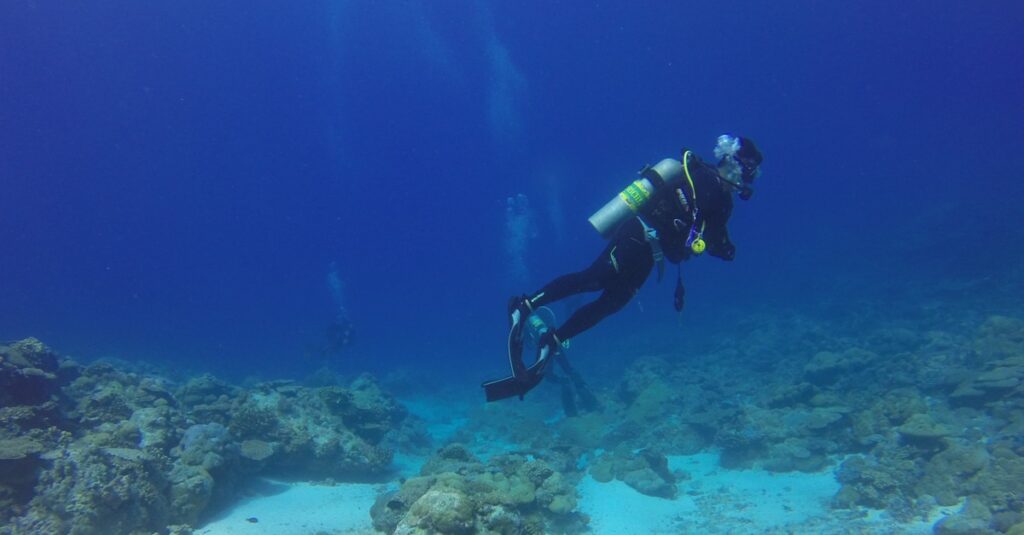

Scuba diving is dangerous at 30 feet, but the risks at this depth are minimal compared to most dives. This is a relatively shallow depth, and it carries lower chances of issues such as decompression sickness, nitrogen narcosis, or running out of air.
In this article, we explore the fascination behind a 30 foot dive and how it relates to other depths. We’ll also touch on the dangers as they relate to depth.
Is 30 Feet Deep for Scuba Diving?
A 30 foot dive is not deep for scuba diving. A shallow depth is usually 30 to 40 feet, so this barely scrapes the surface of how deep you can go with your scuba diving certification.
Benefits of Scuba Diving at 30 Feet
While scuba diving at 30 feet is not necessarily deep, you still get to experience the wonders of diving. It’s conditionally safer than a deeper dive due to:
- Increased visibility
- More opportunity to correct problems
- Less chance of nitrogen-related illnesses
When diving at 30 feet you’re likely to run into more fish, and they’ll be more vibrant and colorful than those deeper down. These won’t be as rare as fish found at depth, but they’re still exciting to see and worth the dive.
What are the Prerequisites for a 30 Foot Dive?
There are two routes you can take if you want to dive 30 feet.
For those short on time, PADI’s Scuba Diver course (or an equivalent from another renowned organization) qualifies you to:
- Dive under direction supervision to a max depth of 40 feet (12 meters)
- Get air fills
- Rent or purchase scuba equipment
Those prepared to invest more in their diving career can head right into the Open Water Diver (or equivalent) course. This bumps you up to a maximum allowed depth of 60 feet (18 meters), future proofing your diving activities and saving you money in the long run.
Regardless of which course you choose, you need proper certification, even for a shallow dive of 30 feet. You’ll need to be at least 10 years or older and have adequate swimming skills and health.
Each course involves a classroom setting to learn skills, techniques, and safety procedures, as well as time in a pool before heading out for a few open water dives.
How Long Can You Scuba Dive at 30 Feet?
You can scuba dive at 30 feet for as long as you have air.
Deeper dives run a higher risk of developing issues such as decompression sickness or nitrogen narcosis, but 30 feet is not deep enough for these to be of major concern.
These problems derive from the absorption of nitrogen and your body needing to get rid of it efficiently. At 30 feet, you aren’t absorbing nitrogen at a rate beyond your body’s capabilities, so you have less to worry about in this area.
Keep in mind that you still use air faster than you would at the surface, and you still need to pay attention to your gauges to make sure you don’t run into problems.
Can You Get The Bends at 30 Feet?
While you can get the bends (decompression sickness) at 30 feet, it’s highly unlikely. This seems to be the starting point for these effects on the body, and they have the potential to get worse the deeper you dive.
The bends are caused by a buildup of nitrogen in your body tissue that does not have adequate opportunity to leave. At the surface, you can get rid of the gas by breathing, but you lack the time and atmospheric conditions to do this underwater.
Because it’s possible at 30 feet, you should still look out for symptoms such as:
- Pain (usually at the joints or muscles of the arms/legs)
- Dizziness
- Numbness or tingling (sometimes paralysis)
- Fatigue (beyond what’s expected from the dive)
- Itchy skin
If you notice any of these issues, even after a shallow 30 foot dive, contact a medical professional and explain the situation to them. They will make sure this does not evolve into a bigger problem and offer treatment options, such as time in a hyperbaric recompression chamber.
At What Depth Does Scuba Diving Become Dangerous?
Scuba diving is dangerous at any depth because the main dangers are inexperience and error. Depth magnifies the ramifications of these issues (i.e. running out of air at 30 feet rather than 60 feet).
This is why you need more training the deeper you dive. Advanced classes refresh your memory on basic techniques and skills while introducing new information for dealing with emergencies and what to pay attention to on a deeper dive.
Your Open Water Diver depths of up to 60 feet (18 meters) won’t be too dangerous. Advanced Open Water Divers touch more on issues such as nitrogen narcosis when diving to max depths of 100 feet (30 meters). To risk a deeper dive, you need the Deep Diver Specialty that allows depth up to 130 feet (40 meters).
Dangers of Scuba Diving Not Related to Depth
While you’ll hear about dangers such as decompression sickness and nitrogen narcosis regularly, it’s easy to forget that lack of knowledge and experience are just as harmful. These issues only magnify the deeper you get, and limitations of your competency are more likely to be exposed during a deeper dive.
Many diving fatalities derive from inadequate experience or physical capabilities. Issues such as nitrogen narcosis or DCS are more likely to occur, but not knowing how to recognize them and respond accordingly can be just as fatal.
Depth correlates to higher risk, but danger is easily offset by proper training and experience. It’s important to stay honest regarding your capabilities, to yourself and others, and take every dive as an opportunity to learn.
References
https://www.padi.com/courses/scuba-diver
https://www.padi.com/courses/open-water-diver
https://www.padi.com/courses/advanced-open-water
https://www.padi.com/courses/deep-diver
https://www.interviewarea.com/faq/how-long-can-you-scuba-dive-at-30-feet
